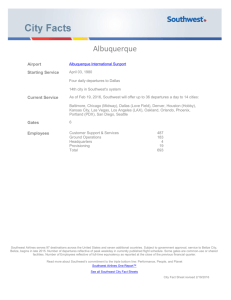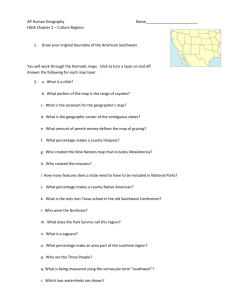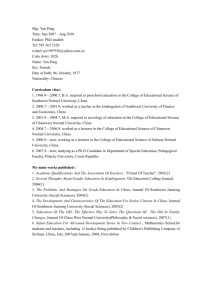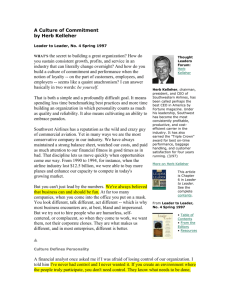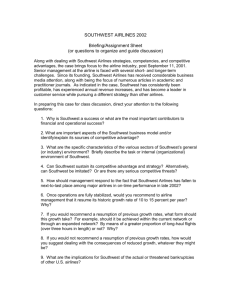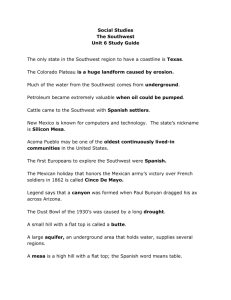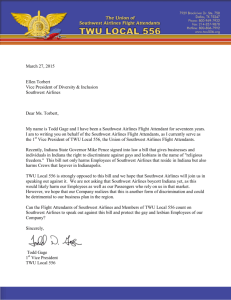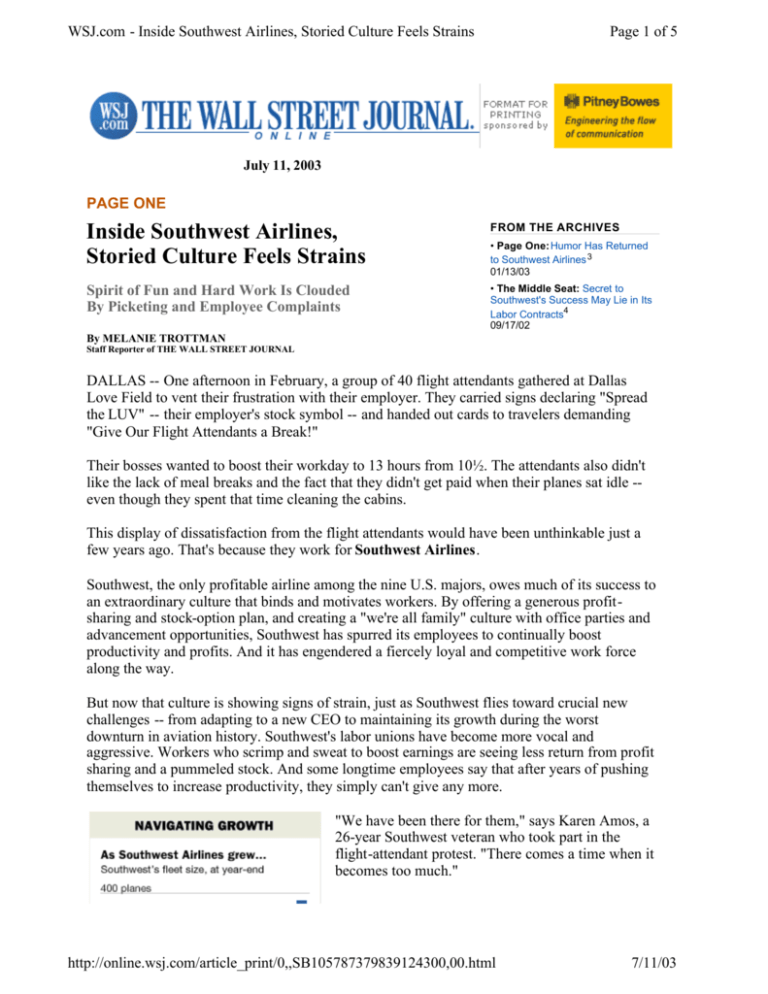
WSJ.com - Inside Southwest Airlines, Storied Culture Feels Strains
Page 1 of 5
July 11, 2003
PAGE ONE
Inside Southwest Airlines,
Storied Culture Feels Strains
FROM THE ARCHIVES
Spirit of Fun and Hard Work Is Clouded
By Picketing and Employee Complaints
• The Middle Seat: Secret to
Southwest's Success May Lie in Its
Labor Contracts4
09/17/02
• Page One: Humor Has Returned
to Southwest Airlines 3
01/13/03
By MELANIE TROTTMAN
Staff Reporter of THE WALL STREET JOURNAL
DALLAS -- One afternoon in February, a group of 40 flight attendants gathered at Dallas
Love Field to vent their frustration with their employer. They carried signs declaring "Spread
the LUV" -- their employer's stock symbol -- and handed out cards to travelers demanding
"Give Our Flight Attendants a Break!"
Their bosses wanted to boost their workday to 13 hours from 10½. The attendants also didn't
like the lack of meal breaks and the fact that they didn't get paid when their planes sat idle -even though they spent that time cleaning the cabins.
This display of dissatisfaction from the flight attendants would have been unthinkable just a
few years ago. That's because they work for Southwest Airlines.
Southwest, the only profitable airline among the nine U.S. majors, owes much of its success to
an extraordinary culture that binds and motivates workers. By offering a generous profitsharing and stock-option plan, and creating a "we're all family" culture with office parties and
advancement opportunities, Southwest has spurred its employees to continually boost
productivity and profits. And it has engendered a fiercely loyal and competitive work force
along the way.
But now that culture is showing signs of strain, just as Southwest flies toward crucial new
challenges -- from adapting to a new CEO to maintaining its growth during the worst
downturn in aviation history. Southwest's labor unions have become more vocal and
aggressive. Workers who scrimp and sweat to boost earnings are seeing less return from profit
sharing and a pummeled stock. And some longtime employees say that after years of pushing
themselves to increase productivity, they simply can't give any more.
"We have been there for them," says Karen Amos, a
26-year Southwest veteran who took part in the
flight-attendant protest. "There comes a time when it
becomes too much."
http://online.wsj.com/article_print/0,,SB105787379839124300,00.html
7/11/03
WSJ.com - Inside Southwest Airlines, Storied Culture Feels Strains
Page 2 of 5
Southwest acknowledges it is seeing more problems
as it moves from adolescence to adulthood, but the airline says it also has more people and
measures in place to fix them. Over the past decade, Southwest has started "culture" programs
in all 58 cities it serves, appointing ambassadors to disseminate corporate news and hold
parties and picnics to foster team spirit. A "second wind" team helped establish seminars to
address employee burnout and the seven-year itch.
From its first flight in June 1971, Southwest's culture was a reflection of one of its founders,
Herbert D. Kelleher. Mr. Kelleher, who stepped down as CEO in June 2001 to assume a more
limited role as chairman, drank Wild Turkey at company parties, smoked everywhere -- even
behind the podium at shareholder meetings -- and loved to joke with employees and dole out
hugs and kisses as greetings. Fun and humor were essential, he preached.
Original employees -- many of whom say they considered him more of a father than a boss -wanted to please and emulate him. Workers routinely went above and beyond the call of duty
to help the airline thrive. During the Gulf War, flight attendants volunteered to give up pay for
vacation days to help the airline pay for fuel.
The motivation wasn't just company loyalty. In the mid-1970s, Southwest became the first
airline to start a profit-sharing plan and added a stock-purchase plan in 1984. In 1991, it
started a stock-option plan that now includes many employees but not the flight attendants.
The stock, which has risen more than a thousandfold since 1972, has produced millionaires
throughout company ranks, down to mechanics and flight attendants. Even with the stock
declines, a $10,000 investment in early July of 1984 would be worth just over $200,000 today.
With so much of employees' personal holdings and compensation tied to the company's
performance, peer pressure to keep costs down grew intense. Workers still routinely challenge
each other on questionable sick calls, overuse of office supplies and requests for overtime pay
for "stupid things," says Dan Kennedy, an operations agent in Spokane, Wash.
Employees recycle everything possible, saving paper clips and making scribble pads out of old
mail. In 1994, Rhonda Holley, a flight attendant, suggested using plain trash bags on airplanes,
instead of printing ones with the airline's logo. The switch saved $300,000 a year.
Flight attendants pitch in to hurriedly clean planes to get them back in the air within 25
minutes; some even help when they're traveling off-duty. Pilots have helped ramp agents load
bags to keep flights on time, and they log more flight hours per day on average than their peers
at other airlines. Three years ago, when Mr. Kelleher challenged each employee to save $5 a
day, Debra Benton, who heads the airline's frequent-flier program, started using the stairs
instead of the elevator to save electricity.
"Part of our working environment means working our butts off," says Colleen Barrett,
Southwest's president.
Last year, Southwest's unit labor costs -- which track the cost to fly one seat one mile -- were
22% below those at Continental Airlines, even though the two airlines' average salaries were
about the same, around $60,000. Southwest's costs were a whopping 41% below those at
AMR Corp.'s American, but American's average salary was nearly $80,000.
http://online.wsj.com/article_print/0,,SB105787379839124300,00.html
7/11/03
WSJ.com - Inside Southwest Airlines, Storied Culture Feels Strains
Page 3 of 5
Such results have helped Southwest post 30 consecutive years of profits and turn it into the
fourth-biggest airline in terms of U.S. domestic service. Many carriers, new and old, are trying
to emulate Southwest's low-cost, no-frills formula.
Yet that formula is under mounting pressure. Southwest, which led the industry in on-time
performance for most of the 1990s, slipped to second in 1999 and has bounced in and out of
the lead ever since. Last year, it ranked sixth among the nine major carriers.
Executives cite increased security measures as one reason for the change. They also note that
Southwest hasn't reduced its flight schedule during the industry slump, as most other airlines
have.
Many veterans of the airline have complained that they have worked increasingly hard to
boost productivity and profits, but without matching pay raises.
Lately, unions have increasingly sought "big airline" pay to match the
airline's growing success, as opposed to the old days, when they'd settle
for other incentives to help their underdog airline fly higher. In 1994, for
example, in exchange for a stock-option award in their contract, pilots
agreed to a five-year wage freeze that would help the company keep
costs in check.
Unions are showing more frustration during negotiations, unlike the old
days, when deals would generally be made more quickly and amicably.
In the summer of 2001, ramp workers picketed near company
headquarters with signs reading, "Record Profits Empty Pockets." They
complained that staff shortages, combined with Southwest's record
passenger loads and a drive to improve on-time performance, meant
they had to lift more bags and do so more quickly. And that, they argued, put them at greater
risk of injury.
Management added staff, and the workers say they won raises of at least 26% and as much as
107% over the life of the original six-year contract, including increases for advancement in
seniority rankings, with the most senior ramp agents getting the lesser amount and the most
junior getting the greater amount. Union officials say they have no lingering hard feelings
toward management.
Meanwhile, the negotiations with the flight attendants have entered their 13th month.
Management dropped the proposal about increasing daily hours, but the two sides are far apart
on other issues. "In the old days," says Ms. Amos, "they would have negotiated more fairly."
Southwest CEO Jim Parker says that complaints are part of any negotiating process.
Management's goal is to get a "good contract" for the attendants, he adds.
Many of the company's top motivational techniques aren't working as well as they used to.
Consider stock options and profit sharing, which have lost a lot of their allure during the
airline slump. Southwest's net income fell 53% to $241 million last year from $511 million a
year earlier. Its stock hit a low of $10.90 last year. Shares have inched back up to about $18,
well below the five-year, split -adjusted high of nearly $24.
http://online.wsj.com/article_print/0,,SB105787379839124300,00.html
7/11/03
WSJ.com - Inside Southwest Airlines, Storied Culture Feels Strains
Page 4 of 5
The slump has hit morale in other ways. Southwest's growth -- as measured in the seating
capacity of its fleet -- has slowed to 4% to 5% annually from its traditional 8% to 10%. The
airline typically launches service in at least two cities a year. It hasn't done so in 21 months.
That restricts advancement opportunities for pilots, station managers and many others, and
employees lose the excitement of conquering new territory.
At the same time, Southwest has found it tougher to maintain its underdog fighting spirit.
Southwest, which now has more planes than Continental, often finds itself playing the
incumbent under attack from new upstarts, such as JetBlue Airways.
Growth has also made upper management more remote from the rank and file. In the early
days of the company, corporate den mother Ms. Barrett could send hand-written notes of
compliment or condolence to many of the company's 517 employees. She still writes notes,
but only reaches a fraction of the company's more than 35,000 workers, who are spread from
Manchester, N.H., to San Diego.
Some employees say that newer hires just don't get how special the culture is. "Southwest
treats its employees so well, and really takes care of them if they stay," says Susan Goodman,
who joined Southwest in 1975 as a flight attendant and now coordinates legislative efforts
among employees, such as organizing petition drives. "I think some of the younger ones don't
understand."
In the face of difficulty in the past, Mr. Kelleher would usually step to the forefront and rally
the troops, something he has an uncanny ability to do. He is still treated much like a rock star
when he walks into a room full of workers. For now, however, the 72-year-old executive is
concentrating on Washington lobbying and industry commissions, given the crisis in the
industry since Sept. 11.
The new CEO, Mr. Parker, kept a low profile as Southwest's corporate lawyer and is
considered more staid than the effervescent Mr. Kelleher. "Jim is not Herb," says longtime
Southwest board member June Morris. "Obviously he doesn't have a flamboyant personality,
and he's smart enough to not try. He's very bright and he's a superb speaker."
Southwest executives say recent complaints from employees don't necessarily indicate waning
loyalty. An overwhelming number of employees remain devoted to the company's success and
are proud of their high productivity, executives say.
Mr. Parker says the airline's work ethic remains critical to its success. "Our cost advantage is
not based on low wages," he says. "We pay very competitive wages. It is based on our
employees' hard work."
He is doing his part to keep the culture alive. He used to disapprove of the company's annual
daylong Halloween celebration; dressing up in costumes and doing comedy sketches didn't
seem productive. But he came to see that the party preparations were a model of teamwork and
employee bonding. So last year the CEO paraded through headquarters in a judge's robe and
wig, evaluating workers' sketches with a smile.
Southwest has also made an effort to help workers who have been at the company a long time
and whose enthusiasm is flagging. In 1997, the airline established its "second wind" team of
http://online.wsj.com/article_print/0,,SB105787379839124300,00.html
7/11/03
WSJ.com - Inside Southwest Airlines, Storied Culture Feels Strains
Page 5 of 5
20 employees who for several years helped set up libraries of stress-relief books in offices
across the country and gave 90-minute seminars on burnout. Much of the advice for avoiding
overload recalled Mr. Kelleher's emphasis on fun: Workers were taught to value "kid spirit" by
taking "joy breaks," such as staging yo-yo contests or hopscotch games in the office. They also
were taught to look at every weekend as a "mini-vacation," so that they'd have something to
plan and look forward to each week.
Young workers, meanwhile, sometimes need to be told the opposite. Ms. Barrett says that
some recruits who have never had a job before misunderstand the culture of Southwest and see
it as one big party. The company has probationary periods for new hires, and "peer pressure is
very intense" to work hard, she says. If someone isn't working out, "We won't let it drag on."
Write to Melanie Trottman at melanie.trottman@wsj.com 5
URL for this article:
http://online.wsj.com/article/0,,SB105787379839124300,00.html
Hyperlinks in this Article:
(1) http://online.wsj.com/article/0,,SB105779268268411600,00.html
(2) http://online.wsj.com/page/0,,2_2119,00.html
(3) http://online.wsj.com/article/0,,SB1042409678722754624,00.html
(4) http://online.wsj.com/article/0,,SB1032201029177655435,00.html
(5) mailto:melanie.trottman@wsj.com
Updated July 11, 2003
Copyright 2003 Dow Jones & Company, Inc. All Rights Reserved
Printing, distribution, and use of this material is governed by your Subscription agreement and Copyright laws.
For information about subscribing go to http://www.wsj.com
http://online.wsj.com/article_print/0,,SB105787379839124300,00.html
7/11/03


